Andhra Pradesh BIEAP AP Inter 2nd Year Botany Study Material 9th Lesson Principles of Inheritance and Variation Textbook Questions and Answers.
AP Inter 2nd Year Botany Study Material 9th Lesson Principles of Inheritance and Variation
Very Short Answer Questions
Question 1.
What is the cross between the F1 Progeny and the Homozygous recessive parent called? How is it useful?
Answer:
Test cross. It is used to test whether an Individual is Homozygous (pure) or Heterozygous (Hybrid).
Question 2.
Do you think Mendel’s laws of inheritance would have been different if the characters that he chose were located on the same chromosome?
Answer:
Yes, it depends on the linkage of genes on the same chromosome.
Question 3.
Who proposed the Chromosome theory of inheritance?
Answer:
Walter Sutton and Theodore Boveri.
Question 4.
Define true breeding. Mention its significance.
Answer:
All offsprings has the same phenotype as its parents is called the breeding. They express characters for several generations.
Question 5.
Explain the terms Phenotype and Genotype.
Answer:
The Physical or external appearance of a character is called Phenotype. The genetic makeup of an individual is called Genotype.
![]()
Question 6.
What is point mutation? Give an example.
Answer:
Mutation which occurs in a single base pair of DNA is called point mutation.
E.g.: Sickle cell anemia.
Question 7.
What is the genotype of wrinkled phenotype of pea seeds?
Answer:
rr is the genetic nature of the phenotypic wrinkled pea seeds.
Question 8.
What will be the phenotypic ratio in the offsprings obtained from the following crosses.
a) Aa x aa b) AA x aa c) Aa x Aa d) Aa x AA
Note : Gene A is dominant over gene a.
Answer:
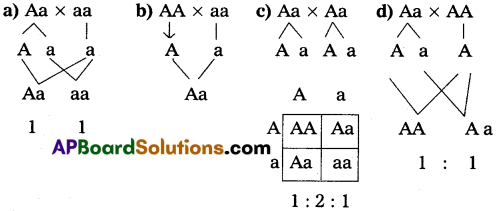
Question 9.
In garden pea, the gene T for tall is dominant over its allele for dwarf. Give the genotypes of the parents in the following crosses.
a) Tall x Dwarf producing all tall plants.
b) tall x tall producing 3 tall and 1 dwarf plants.
Answer:

Short Answer Questions
Question 1.
Mention the advantages of selecting pea plant for experiment by Mendel.
Answer:
- It is an annual plant that has well defined characteristics.
- It can be grown and crossed easily.
- It has bisexual flowers containing both male and female parts.
- It can be self fertilized conveniently.
- It has a short life cycle and produces large number of offsprings.
Question 2.
Differentiate between the following.
a) Dominant and Recessive b) Homozygous and Heterozygous
Answer:
| Dominant | Recessive |
| a) The characters which are expressed phenotypically in both homozygotes and heterozygotes or”The allele or gene that shows up”. | The character which is not expressed phenotypically in heterozygous condition or the allele that is masked. |
| Homozygous | Heterozygous |
| b) An individual having two similar or identical alleles for a single character. Hence it will produce only one kind of gametes. | An individual having two different alleles for a single character. Hence it will produce two different types of gametes. |
Question 3.
Explain the law of Dominance using a Monohybrid cross.
Answer:
Characters are controlled by discrete units called factors. Factors occur in pairs. In a dissimilar pair of factors pertaining to a character one number of the pair dominates the other. The law of Dominance is used to explain the expression of only one of the parental characters in a Monohybrid cross in the F1 generation and the expression of both in F2 generation in the ratio of 3 : 1.
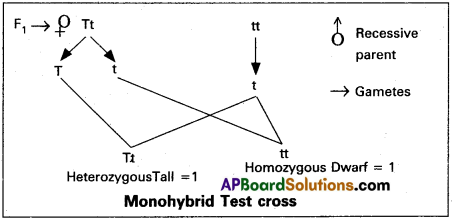
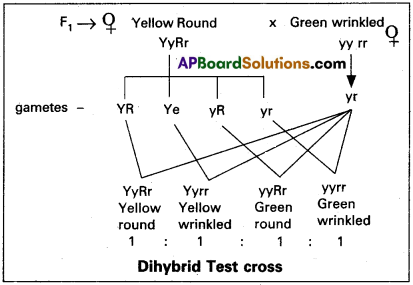
Question 4.
Define and design a test cross.
Answer:
Crossing between Fx indivi – duals with the recessive parent is called test cross. It is used to test whether an individual is homozygous or heterozygous. A mono hybrid test cross gives a phenotype ratio of 1 : 1 and a dihybrid test cross gives a ratio of 1 : 1 : 1 : 1.
![]()
Question 5.
Explain the co-dominance with example.
Answer:

a) Co-dominance:
The phenomenon where heterozygotes have features of both the homozygotes, that is, an allele is neither dominant nor recessive to the other. 1) Different types of red blood cells that determine ABO blood grouping in humans 2) Seed coat pattern size in lentil plants. A cross between pure breeding spotted lentils with pure breeding dotted lentils produce heterozygotes. These Fx hybrids show the phenotypic features of both parents which means that neither the spotted nor the dotted, allele is dominant or recessive to the other. Because both traits show up equally in the heterozygote’s phenotype, the alleles are termed co-dominant. F1 plants are self pollinated produce F2 progeny in the ratio of (lspotted : 2 spotted and dotted : 1 dotted).
Question 6.
Explain the Incomplete Dominance with example.
Answer:
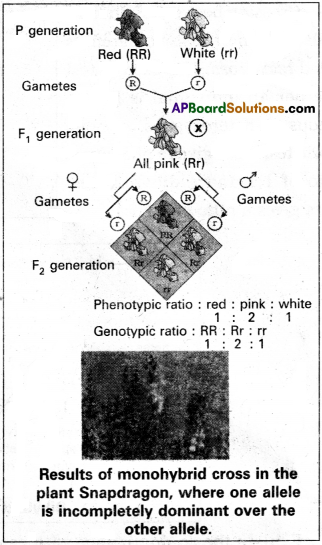
Incomplete Dominance: It is the condition where one allele of a gene is not completely dominant over the other allele and results in the heterozygous having phenotype different from the dominant and recessive homozygotes.
In a cross between true beeding red flowered plants (RR) and true white flowered plants, (rr) the F1 was pink (Rr). When the F1 was self pollinated, the F2 resulted in the ratio of 1(RR) : 2(Rr) : 1(rr)
Red Pink White
Here the genotype ratios were as in monohybrid cross of Mendel but the phenotypic ratio had changed from the 3 : 1 because, R was not completely dominant over r and is possible to distinguish Rr as pink from RR and rr. Thus the phenotypic and genotypic ratios in F2 progeny are the same, that is 1 : 2 : 1.
Question 7.
Write a brief note on chromosomal mutations and gene mutations.
Answer:
a) Chromosomal mutations :
Any change in the number or structure of chromosomes are called chromosomal mutations. They may be
a) Structural changes :
During prophase I of Meiosis, homologous regions of chromosomes show many changes in structure inorder to form pairs or bivalents. They are :
1) Deletion : A part of chromosome is lost or broken.
2) Duplication : A particular part of chromosome is repeated.
b) Gene Mutations :
Mutations which occur due to change in a single base pair of DNA are called gene mutations or point mutations.
Question 8.
Define Law of Segregation and Law of Independent Assortment.
Answer:
Law of segregation :
The two alleles of a gene when present together in a heterozygous state, they do not fuse or blend in any way but remain distinct and segregate during meiosis or in the formation of gametes, so that each meiotic product of gamete will carry only one of them.
Law of Independent Assortment:
When two pairs of traits are combined in a hybrid, seggregation of one pair of characters is independent of the other pair of characters.
Long Answer Question
Question 1.
Explain the dihybrid cross with the help of punnel square board by taking contrasting traits, seed colour and seed shape.
Answer:
The cross made between individuals differing in two characters is known as Dihybrid cross. Mendel studied the inheritance of two characters at a time. Mendel crossed a homozygous pea plant having yellow and round seeds with another pea plant having green and wrinkled seeds. The F1 hybrids were found to have yellow and round seeds. This shows that are dominant.
When F1 plants allowed to cross among themselves, four distinct types of seeds appeared in F2 generation. Two of these were similar to parental combinations, while the other two were new combinations. The phenotypic ratio of 9 : 3 : 3 : 1 can be derived as a combination series of 9 round yellow, 3 round green, 3 wrinkled yellow, 1 wrinkled green.
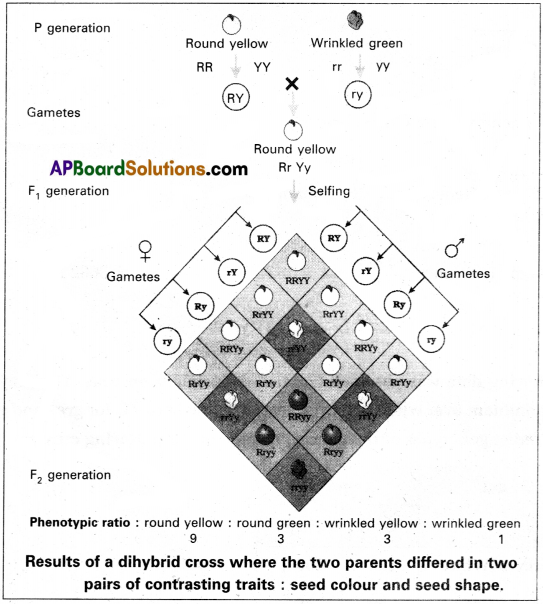
Intext Questions
Question 1.
Mendel crossed pea plants producing round seeds with those producing wrinkled seeds. From a total of 7324 F2 seeds, 5474 were round and 1850 were wrinkled. Using the symbols R and r for genes, predict the a) the parental (p) genetypes, b) the gametes, c) F1 progeny, d) the cross between F1 hybrids, e) genotypes, phenotypes, genotypic frequency, phenotypic ratio of F2 progeny.
Answer:
a)
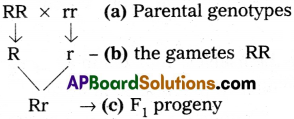
d) Cross between F1 hybrids

e) 3 : 1 – phenotypic ratio of F2 progeny
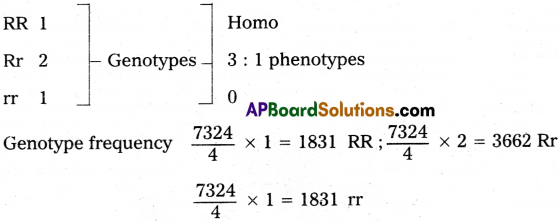
Question 2.
The following data was obtained from an experiment on peas. The grey coloured seed is dominant over white coloured seed. Use the Letter G for grey and g for white traits. Predict genotypes of the parents in each of the following crosses.
| Parent | Progeny | |
| Grey | White | |
| a) Grey × White | 164 | 156 |
| b) Grey × Grey | 59 | 19 |
| c) White × White | 0 | 100 |
| d) Grey × Grey | 180 | 0 |
Answer:
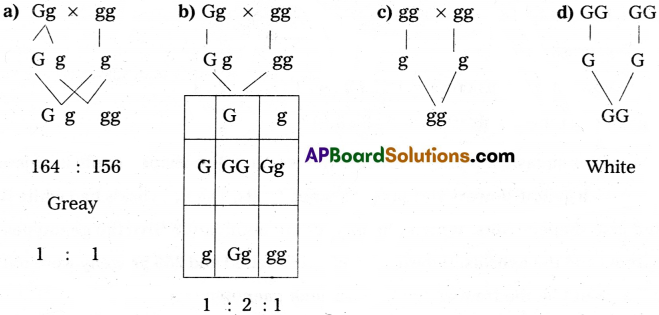
Question 3.
In tomatoes red fruit colour (R) is dominant yellow (r). Suppose a tomato plant homozygous for red is crossed with one homozygous for yellow. Determine the appearence of following.
a) The F1, b) The F2, c) The offspring of a cross of the F1 back to the red parent, d) The offspring of a cross of the F1 back to the yellow parent.
Answer:

Question 4.
In pea, axillary position of flowers T is dominant over its terminal position (t). Coloured flowers (C) are dominant to white flowers (c). A true breeding plant with coloured flowers in axils is crossed to one with white terminal flowers. Give the phenotypes, genotypes and expected ratios of F1, F2 back cross and test cross progenies. What genotype ratio is expected in the F2 progeny?
Answer:
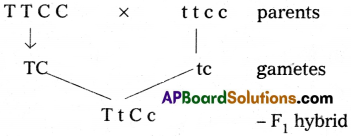
In Back cross 1 : 1 : 1 : 1
Test cross 1 : 1 : 1 : 1
Genotypic ratio of this cross = 1 : 2 : 2 : 4 : 1 : 2 : 1: 2 : 1
Phenotypic ratio of this cross = 9 : 3 : 3 : 1
![]()
Question 5.
In summer squash, a plant with white flowers and disc shaped fruits is crossed to a plant with yellow flowers and sphere shaped fruits. The F1 hybrids had white flowers and disc shaped fruits. Which phenotypes are obminant? Give the genotypes of the parents and the hybrids. If these hybrids were selfed and 256 progeny were obtained, what would be the frequency of the various phenotypes?
Answer:
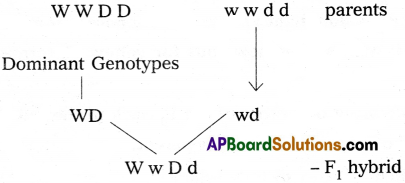
In dihybrid cross 9 : 3 : 3 : 1 phenotypic ratio is obtained.
The hybrids were selfed gives 256 progeny. Among them
White disc shaped fruits are 144 [\(\frac{256}{19}\) × 9
White sphere shaped fruits = 48 \(\frac{256}{10}\) × 3
Yellow; disc shaped fruits = 48 \(\frac{256}{16}\) × 3
Yellow sphere shaped fruits = 16 \(\frac{256}{16}\) × 1]
Question 6.
Give the ratios of the following
a) Monohybrid test cross
b) Dihybrid test cross
c) F2 Phenotypic ratio of mono-hybrid cross
d) F2 Phenotypic ratio of dihybrid cross
e) F2 Genotypic ratio of monohybrid cross
f) F2 Genotypic ratio of dihybrid cross.
Answer:
a) 1 : 1
b) 1 : 1 : 1 : 1
c) 3 : 1
d) 9 : 3 : 3 : 1
e) 1 : 2 : 1
f) 1 : 2 : 2 : 4 : 1 : 2 : 1 : 2 : 1
Question 7.
A diploid organism is heterozygous for 4 loci. How many types of gametes can it produce?
Answer:
Locus is a fixed position on a chromosome which is occupied by a single or more genes. A diploid organisms which is heterozygous at four loci, will have over different contratling characters at four different loci. For example the organisms have Aa, Bb, Cc, Dd then during meiosis, it will seggregate to form 8 separate gametes.
If the genes are not linked, then the diploid organism will produce 16 different gametes. However if the genes are linked, the gametes will reduce their number as the genes might be linked and the linked genes will be inherited togethers during the process of meiosis.
Question 8.
What is crossing over? In which stage of cell division crossing over occurs? What is its significance?
Answer:
Exchange of chromatid segments between two homologous chromosomes is called crossing over. It ccurs in pachytene sub stage of meiosis. It leads to the evolution of new genetic recombinations.
Question 9.
“Genes contain the information that is required to express a particular trait”. Explain.
Answer:
Genes are the functional segments of DNA, which is a part of chromosome, controls traits. If proteins work efficiently then trait get expressed in a better way, height depends on the release of growth hormones by proteins. Thus through proteins present in genes, genes controls the traits.
Question 10.
For the expression of traits, genes provide only the potentiality and the environment provides the opportunity. Comment on the varaeity of the statement.
Answer:
Phenotype = Genotype + Environment
Trait = (Potentiality) (Opportunity)
Question 11.
Two heterozygolis parents are crossed. If the two loci are linked what would be the distribution of phenotypic features in F1 generation for a dihybrid cross?
Answer:

The above condition explained by using dihybrid crosses in drosophila were carried out by Morgan. He crossed yellow bodied (y) and white eyed (w) female with brown bodied (y+) and red eyed (w+) male, which produced F1 with brown bodied red eyed female and yellow bodied white eyed male.
Question 12.
In peas, tallness is dominant over dwarfness and violet colour of flowers is dominant over the white colour. When a tall plant bearing violet flowers was pollinated with a dwarf plant bearing white flowers, different phenotypic groups were obtained in the progeny in numbers mentioned against them.
Tall, violet = 138
Tall, white = 132
Dwarf, violet = 136
Dwarf, white = 128
Mention the genotypes of the two parents and of the four offsprings.
Answer:
Tall plant violet flowers
Dwarf plant white flowers
Test cross:
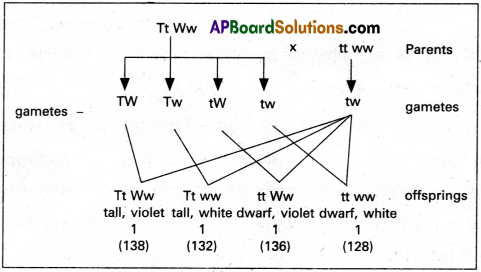
![]()
Question 13.
How do genes and chromosomes share similarities from the view point of genetical studies?
Answer:
The genes are located on chromosomes so therefore they both contain genetic information.
Gene :
A gene is an ordered sequence of nucleotides located in a particular position on a particular chromosome that encodes a specific functional product.
Chromosome components in a cell that contain genetic information. Each chromosome contains genes. Chromosomes occur in pairs, one from mother and one from father.